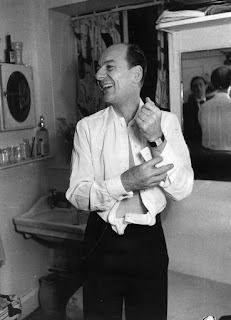Vocal Warm-ups
Vocal Warm-ups
There is a story of when Sir John Gielgud was working with Peter Brook on Shakespeare’s The Winter’s Tale in 1952. Peter Brook was into doing lots of warm ups and improvisations sometimes all day sometimes. After 3 hours of vocal warm up and then improvisations where actors had to show emotions and induce and create an emotional reaction in the audience of Brook and his assistant. Brook would tell the actors what emotion they had to show. One actress was given fear and came out on stage and raised her voice and arms and showed great emotion as she improvised a speech about when she found her mother dead in her apartment two years previously. Brook was impressed. It was then Gielgud’s turn. He went up on the stage. He was given despair. He turned his back on the audience. Gielgud then turned around emotionless and forthright and said, “We open in one week and we haven’t even picked up the bloody script.”He then walked off the stage and sat down again.
Actors and students love and hate vocal warm ups. They are essential to warm up one of the major tools you need as a drama student or an actor. Your voice is a main instrument of expression as an actor, and warming it up will prevent damaging your vocal cords while helping you articulate your words. Here are a couple of oldies but goldies.
The Lion and the Mouse - Muscle Stretching
Open your mouth wide, like a lion roaring. Then scrunch your face into a meek, small, expression, like a mouse. Switch back and forth.
Noosa Wave
Stretch your tongue. Pull your tongue out, pull it down as far as you can, then up, then side to side. Now put the tip of your tongue behind your bottom teeth. Rest your tongue. Now push the middle of your tongue forward and upward like a wave. Stretch the middle of the tongue. Now, like a wave receding, let the tongue go back and down and rest on the floor of the mouth. This will help you move your tongue, open your mouth and to enunciate and articulate. Your voice is your main instrument of expression as an actor, and warming it up will prevent damaging your vocal cords while helping you articulate your words.
The ‘Hum
Exhale slowly, humming until you have exhaled all of your air. Repeat approximately five times.
The ‘Ha’
Stand and place your hand on your abdomen. Breathe in by expanding your stomach outward; you are now breathing from your diaphragm. Exhale slowly, uttering, "ha ha ha ha." Push you abdomen in with every syllable. Repeat.
Lip trills and flutters
Roll your tongue on the roof of your mouth to make “trr” or “rr” sound. Descending nasal consonants. Say the word “onion,” stretching the “ny” sound and voice it downward in pitch.
Tongue twisters
Memorize a few of tongue twisters, like “red leather yellow leather” and repeat them to get your mouth loosened up. Yawn and sigh before and between all tongue twisters. Open your mouth as if to yawn and let your voice sigh loudly from the top of your register down to its lowest note. Many tongue twisters concentrate on plosive sounds like p, b, t, d, k, g. Others concentrate on resonant sounds like m and n. Some other use more difficult sounds and combinations such as those involving the r sound. Here are some other Tongue Twisters. Try doing each 6-10 times before moving onto the next one:
Mommala Poppala Mommala Poppala
Peggy Babcock
I carried the married character over the barrier
Honorificabilitudinatibus (from Shakespeare’s Love’s Labour's Lost)
A regal rural ruler
Green glass grass gleams
A proper pot of coffee in a proper pot of coffee pot
You Know New York, You Need New York, You Know You Need Unique New York
Wrist Watch Wrist Watch
Get Grandma Great Greek Grapes



Comments
Post a Comment